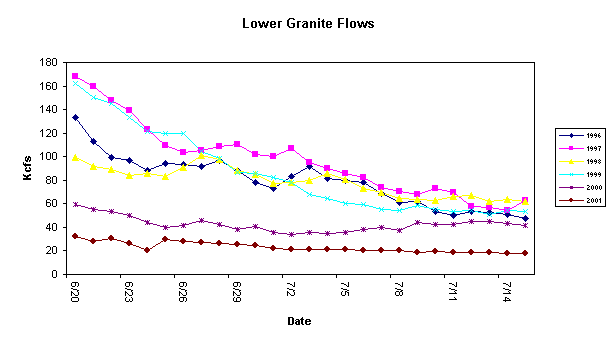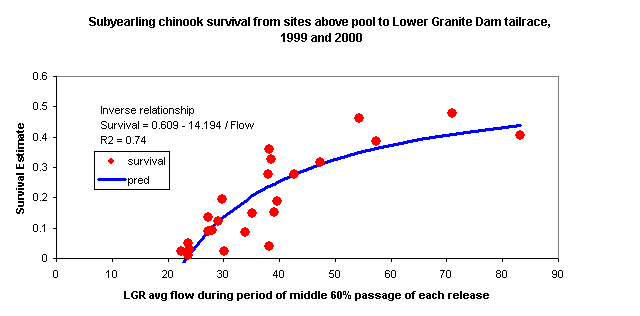
Christine Mallette, Chairperson, Salmon Managers
-
July 2nd, 3rd and
4th - release 5 Kcfs
July 5th and July 6th - release 7 Kcfs
July 7th and July 8th - release 10 Kcfs.
| TO: | Brigadier General Strock | COE-NPD |
| William Branch | COE - Water Management | |
| Cindy Henriksen | COE-RCC | |
| Doug Arndt | COE-P | |
| Col. Randall J. Butler | COE - Portland District | |
| Lieut. Col. W. E. Bulen, Jr. | COE - Walla Walla District | |
| J. William McDonald | USBR-Boise Regional Director | |
| Steven Wright | Acting BPA-Administrator | |
| Greg Delwiche | BPA-PG-5 | |
| FROM: |
 Christine Mallette, Chairperson, Salmon Managers |
|
| DATE: | June 26, 2001 | |
| SUBJECT: | Dworshak Operations | |
| SPECIFICATIONS: |
1) For the week beginning July 2, operate Dworshak at the following
discharge levels:
July 5th and July 6th - release 7 Kcfs July 7th and July 8th - release 10 Kcfs. |
|
JUSTIFICATION:
Research conducted by both National Marine Fisheries Service and the US Fish and Wildlife Service has concluded that flow augmentation from Dworshak Reservoir provides a significant survival benefit to juvenile migrating subyearling chinook salmon. This benefit accrues from both a reduction in the water temperature in Lower Granite Reservoir and an increase in flow. The temperature at the Lower Granite forebay monitor is presently reading 66° F and has increased by approximately 2 degrees F over the last two days. The typical trend for temperatures at this location is for temperature to increase rapidly during late June and through July. Water quality modeling conducted by both the EPA and U.S. Army Corps of Engineers has shown releases of cool water from Dworshak Reservoir can cool the water temperature in Lower Granite Reservoir. Releases of cool water from Dworshak starting July 2 will coincide with the forecasted increase in temperature for central Idaho. In addition to temperature control, flows at Lower Granite are far below the flow targets contained in the 2000 Biological Opinion. The following graph shows flows this year compared to the past five years. The line plotted for 2001 depicts the actual flows at Lower Granite through June 25th and the June 26th SSARR predicted flows (minus Dworshak augmentation) for the remainder of the period. As seen in the graph the flows are considerably less than normally occur during this time period in more "near average" to "above average" years.

These flow levels are harmful to the survival of juvenile fall chinook. The following graph shows the relation developed for subyearling fall chinook survival between release and the Lower Granite Tailrace for fish PIT tagged at the three acclimation ponds (Big Canyon Creek, Pittsburg Landing, and Captain John Rapids) and released with production in 1999 and 2000.

The relation described by these data suggests that without Dworshak flow augmentation no fish would survive to the tailrace of Lower Granite Dam. However, increasing Dworshak discharge and augmenting flow may increase the survival to the 10-20% range. The migration of fall chinook from the lower Snake is well underway. Passage indices of subyearling chinook have shown a steady increase for the past several weeks. Given the flow year and the increasing passage indices of subyearling chinook at Lower Granite Dam it is imperative to begin flow augmentation from Dworshak as soon as possible.